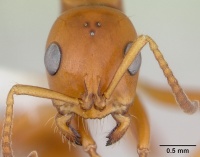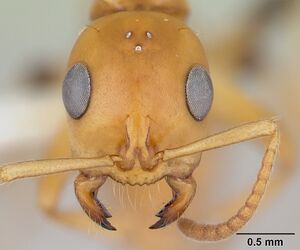Tetraponera hespera
| Tetraponera hespera | |
|---|---|

| |
| Scientific classification | |
| Kingdom: | Animalia |
| Phylum: | Arthropoda |
| Class: | Insecta |
| Order: | Hymenoptera |
| Family: | Formicidae |
| Subfamily: | Pseudomyrmecinae |
| Genus: | Tetraponera |
| Species group: | grandidieri |
| Species: | T. hespera |
| Binomial name | |
| Tetraponera hespera Ward, 2009 | |
Ward (2009) - Occurs sympatrically with Tetraponera grandidieri, Tetraponera hirsuta and Tetraponera merita at one or more localities. Most populations of T. hespera are in seasonally dry rainforest, where colonies tend to nest near the ground level, usually in rotten sticks. One colony from the type locality (PSW10456) was nesting in an earthworm cast on the ground. As in T. grandidieri, observed colony sizes are small (4-36 workers).
Identification
Ward (2009) - A member of the Tetraponera grandidieri group. T. hespera represents an assemblage of variably isolated populations in northwestern Madagascar. This species is most readily recognized by its distinctive color pattern: workers are usually a unicolorous yellow-brown or orange-brown, with contrasting black bands on the legs.
Keys including this Species
- Key to Tetraponera grandidieri species group
- Key to Afrotropical Tetraponera
- Key to Afrotropical Tetraponera species
Distribution
This species is found in northwestern Madagascar, with an isolated population at Ambohijanahary in central western Madagascar. (Ward 2009)
Latitudinal Distribution Pattern
Latitudinal Range: -13.41666667° to -13.41666667°.
| North Temperate |
North Subtropical |
Tropical | South Subtropical |
South Temperate |
- Source: AntMaps
Distribution based on Regional Taxon Lists
Malagasy Region: Madagascar (type locality).
Distribution based on AntMaps
Distribution based on AntWeb specimens
Check data from AntWeb
Countries Occupied
| Number of countries occupied by this species based on AntWiki Regional Taxon Lists. In general, fewer countries occupied indicates a narrower range, while more countries indicates a more widespread species. |

|
Estimated Abundance
| Relative abundance based on number of AntMaps records per species (this species within the purple bar). Fewer records (to the left) indicates a less abundant/encountered species while more records (to the right) indicates more abundant/encountered species. |

|
Biology
Castes
Worker
Images from AntWeb
   
| |
| Holotype of Tetraponera hespera. Worker. Specimen code casent0012865. Photographer April Nobile, uploaded by California Academy of Sciences. | Owned by UCDC, Davis, CA, USA. |
Nomenclature
The following information is derived from Barry Bolton's Online Catalogue of the Ants of the World.
- hespera. Tetraponera hespera Ward, 2009: 295, figs. 2-4, 6, 9-12, 24 (w.q.m.) MADAGASCAR.
Unless otherwise noted the text for the remainder of this section is reported from the publication that includes the original description.
Ward (2009) - In earlier identifications of museum material I employed a code name for this species: Tetraponera psw110. The hespera-like population occupying the Ankarana Massif is divergent in several respects: workers lack the characteristic black leg banding and they have a dorsally narrowed propodeum that appears more or less triangular in shape when seen in posterior view, in contrast to the broadly convex propodeum seen in other populations of T. hespera and in the rest of the T. grandidieri group. Although I considered treating the Ankarana form as a different species, several observations argued against this. (1) It is strictly allopatric to the more typical morph of T. hespera, so there is no “test” of species distinctness in sympatry. (2) Samples from tropical dry forest at Foret Antsahabe, 60 km southeast of Ankarana, have black leg banding but the propodeum tends to be intermediate in shape between the Ankarana morph and more typical T. hespera. (3) A worker (BLF10881; CASENT0053718) from another nearby locality, Foret Binara, has black leg banding and a broadly convex propodeal dorsum-yet it is genetically identical at the mitochondrial COI locus to a worker from Foret Antsahabe. The COI data indicate that all three populations (Ankarana, Antsahabe and Binara) are closely related and form a clade that is sister to T. hespera + T. hirsuta, but with combined nuclear gene sequences the three populations do not form a clade; instead, they are paraphyletic with respect to T. hirsuta. Thus, recognizing the Ankarana form as a distinct species would require an arbitrary division along a gradient of differentiated allopatric populations.
Description
Worker
n = 13. HW 0.95-1.31, HL 1.19-1.55, LHT 1.12-1.53, CI 0.78-0.90, FCI 0.14-0.18, REL 0.30-0.35, REL2 0.35-0.41, SI 0.77-0.83, FI 0.29-0.34, PLI 0.50-0.58, PWI 0.42-0.53.
Similar to Tetraponera grandidieri (q.v.). Basal margin of mandible lacking tooth; anterior clypeal margin broadly convex and crenulate, directed forward; head relatively elongate (CI 0.78-0.90); metanotal spiracle visible in lateral view of mesosoma; dorsal face of propodeum usually broadly convex in posterior view, but more dorsally compressed and subtriangular in one population (see below); standing pilosity and appressed pubescence generally sparse; integument mostly sublucid, with fine coriarious/puncticulate sculpture; body unicolorous yellow-brown or orange-brown, legs usually with contrasting black bands on the distal portions of the femora; banding sometimes weakly developed on the profemur, and absent from all legs in one population.
Type Material
Holotype worker. MADAGASCAR Antsiranana: Nosy Be, 4 km ESE Andoany (=Bellville), 100 m, 13°25'S 48°18'E, 2.v.1989, ex rotten stick on ground, rainforest, P. S. Ward#l0457 (CASENT0012865) (California Academy of Sciences).
Paratypes. Series of workers and queens, same locality and date as holotype, elevation 100-200 m (P. S. Ward#10456, 10457, 10459, 10463, 10465, 10470-1) (The Natural History Museum, CASC, Museum of Comparative Zoology, Philip S. Ward Collection, South African Museum, University of California, Davis).
References
- Ward, P.S. 2009. The ant genus Tetraponera in the Afrotropical region: the T. grandidieri group. Journal of Hymenoptera Research 18: 285-304.
- Ward, P. S. 2022. The ant genus Tetraponera (Hymenoptera: Formicidae) in the Afrotropical region: taxonomic review and key to species. Zootaxa 5102 (1):1-70 (doi:10.11646/zootaxa.5102.1.1).
References based on Global Ant Biodiversity Informatics
- Ward P. S. 2009. The Ant Genus Tetraponera in the Afrotropical region: the T. grandidieri group (Hymenoptera: Formicidae). Journal of Hymenoptera Research: Festschrift Honoring Roy Snelling, 18: 385-304

